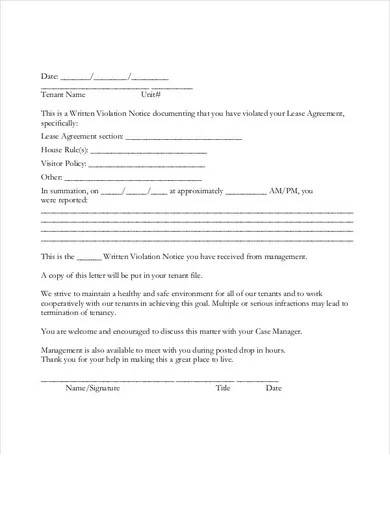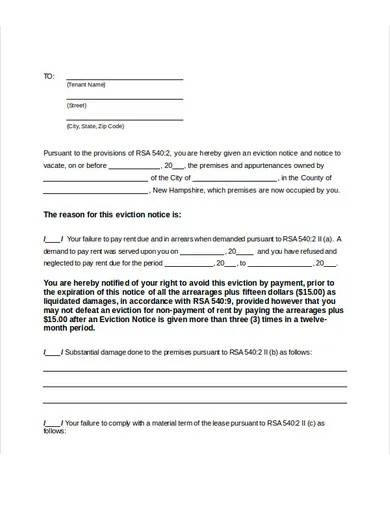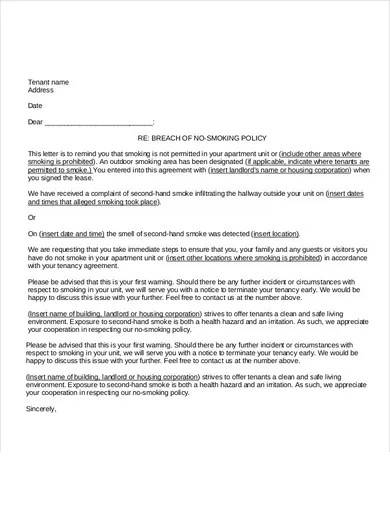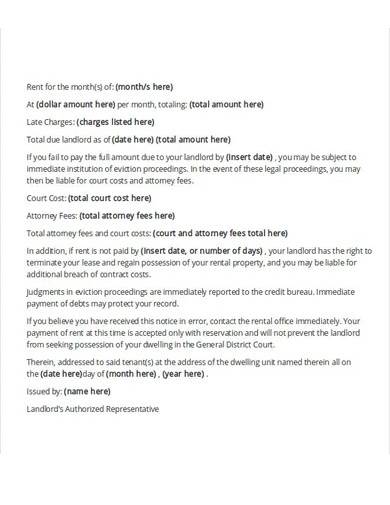Even when you think you’ve screened the most scrupulous applicants and have thoroughly check their background, there’s still a chance that they might turn out the complete of what you hope the would be—an agreement abiding property occupants. It’s never easy for landlords to oversee matters concerning delinquent renters. They have protective rights that shroud them from sudden evictions. A tenant warning letter is a useful tool that the landlords can use to inform tenants of their misconduct and make it better formally.
FREE 7+ Tenant Warning Letter Samples
1. Free Tenant Warning Letter

2. Free Warning Letter to Tenant for Not Paying Rent
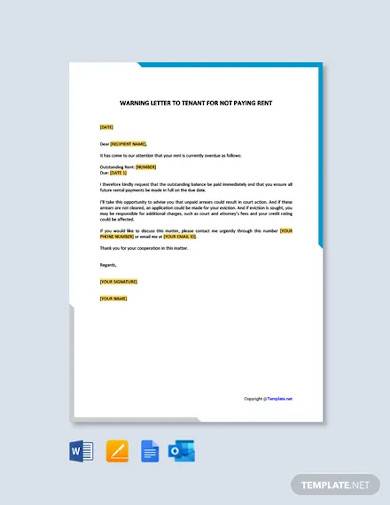
3. Free Warning Letter to Tenant for Late Payment
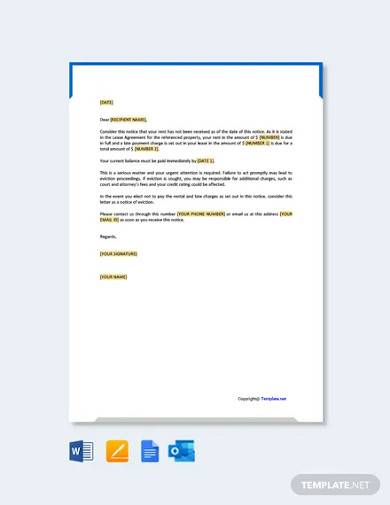
4. Free Warning Letter to Tenant for Violations

5. Tenant Lease Agreement Violation Warning Letter
6. Sample Tenant Eviction Warning Letter
7. Tenant Warning Letter Due to Violation of Policies
8. Sample Tenant Late Rent Warning Letter
What Is a Tenant Warning Letter?
A tenant warning letter is a letter issued by the landlord or the property owner to its tenant to provide the details of the latter’s violation of their tenancy or rental agreement. A warning letter is a way for property managers and owners to impose discipline among people they’re dealing with. This shows that they’re enforcing whatever’s the tenant agreed to adhere to when they moved to occupy the real estate space.
Wayward Tenants: What Can the Landlord Do
As of 2019, there are over 43 million rented housing units in the US. This number has been rising since 2014. Imagine the number of tenants landlords deal daily while actively screening other people to fill in a vacancy immediately. When you’re in a position where you need to meet people from all walks of life, you’ll understand why saints are rare. A huge part of their responsibilities concerns misbehaving tenants such as those who pay late, disrupt neighbors, and purposely destroy properties. Here are some ways how you can deal with them:
1. Provide several payment methods and options. Don’t stick to a single payment plan even when it’s hard for your tenant to fulfill such responsibility. If you only accept monthly payment without an option to make it bi-weekly or other options to make the amount manageable, expect to have a high turnover rate. If you see that the tenant is struggling to manage their cash flow, you can offer to help them by urging them to accept a roommate with whom they can split the bills.
2. Do a thorough screening process. The best to manage a problematic tenant is not to let them in the first place. Take the time to know your prospective renters right at the showing by asking them questions. If you want to talk to people who can tell you about them, contact their previous landlords.
3. Let clashing tenants solve problems on their own. There’s only so much you can do as the property manager to maintain the piece within your establishment. Suppose personal misunderstandings and squabbles break out among them. In that case, it’s best to let them sort the problem on their own unless it’s someone who deliberately wreaks havoc within the property and disrupts the peace and safety of the place.
4. Make a conflict-solving agreement. Anticipate any problem that might come up where you have to deal with a wayward client and include them on your lease agreement. This way, your tenant already knows the consequences if they choose to disobey.
How to Make a Tenant Warning Letter
Here ways on how to make a tenant warning letter:
1. Explain the Violation
The first thing you need to emphasize on your warning letter is the purpose why you’re handing them out a warning in the first place—the violation. Begin your letter right away by stating what limitations or restrictions in your agreement did the tenant deliberately or unknowingly broken. You can also identify if it’s a violation of a much larger regulation, such as those stated by your local state laws on the tenancy. This is why you need to review your lease agreement first and related relevant laws that can help you back your complaint or warning. Mention the findings on your letter by referring to the said laws or agreement terms so the recipient understands what the warning is all about.
2. Provide How the Tenant Can Fix the Situation
If you’re the landlord, you wouldn’t want to lose tenants over a first-time offense. A sudden warning leading to termination without a chance for repercussion or cure is unfair on the tenants’ part. This can paint a rental business a bad image. Provide ways on how the tenant can fix the violation. These involve paying the missed balanced with interest for unpaid rents, removing the pet in a no-pet property, or asking the tenant to mind their noise volume. This raises awareness and will help them take note of what to avoid. This also imposes discipline to uphold the agreement’s rules and build a better relationship between the landlord and its tenants.
3. Lay the Consequences
Specify what consequences they’ll face when they refuse to abide by the warning and continue breaching the agreement’s limitations. There’s only so much warning a landlord can give. For this one, you also need to review the stipulated consequences on the signed contract and the state laws. If it’s prohibited practices within the property, warn the tenant that this may lead to termination when repeated. If it concerns any state tenancy law, provide details on what consequences the law requires, such as penalties. If they deliberately repeat the same blunder without a care for the sent warning, then it might be time to provide an eviction notice instead.
4. Keep the Letter Brief and Focused
As long as you have informed the tenant of their violation’s accurate details and what they need to fix it, there’s no need to make your letter unnecessarily lengthy. Keep it brief and focused. Go directly straight to the point and use layman’s terms. Using complex ideas and complicated words deflects the letter from its purpose of making the tenant understand their violation. Make your letter layout look professional because this will reflect on your business’ image. You can use a letterhead that will contain your logo, business name, and contact number.
FAQs
What are the different types of tenancies?
The tenancies’ different types are fixed-term tenancies, periodic tenancies, boarding house tenancies, and service tenancies.
What are the different types of landlords?
According to Entrepreneur, the different types of landlords are:
- Family investors
- Property management agencies
- Real estate developers
- Mom and pops
- Institutional investors
What legal grounds can a landlord evict a tenant?
A tenant can legally evict a tenant on the following grounds:
- Unpaid rent
- Lease expiration
- Illegal activities within the property
- Property damage
- Violating the agreement
There’s no use in keeping tenants who make your property look bad or who constantly fails to keep their end of the contract. At the end of the day, business is business. A tenant warning letter is your penalty whistle serving as a signal that your tenant overstepped their boundaries. This helps you impose discipline on your property. Avail any of our warning letter templates for your use today.
Related Posts
Cover Letter
Family Reference Letter Samples & Templates
Teaching Resignation Letter Samples & Templates
Teacher Letter of Recommendation Samples & Templates
Payment Letter Formats Samples & Templates
Business Proposal Letter to Client Samples & Templates
Company Introduction Letter Samples & Templates
Resignation Letter for Medical Samples & Templates
Letter of Intent Samples & Templates
Letter of Intent for a Job Samples & Templates
Lease Proposal Letter Samples & Templates
Letter of Inquiry Samples & Templates
Character Reference Letter Samples & Templates
Claims Letter Samples & Templates
Response Letter Sample & Templates

